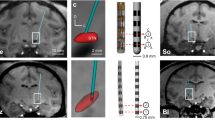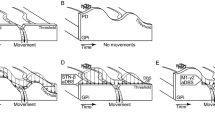Abstract
The different peaks of somatosensory-evoked potentials (SEP) originate from a variety of anatomical sites in the central nervous system. The origin of the median nerve subcortical N18 SEP has been studied under various conditions, but the exact site of its generation is still unclear. While it has been claimed to be located in the thalamic region, other studies indicated its possible origin below the pontomedullary junction. Here, we scrutinized and compared SEP recordings from median nerve stimulation through deep brain stimulation (DBS) electrodes implanted in various subcortical targets. We studied 24 patients with dystonia, Parkinson’s disease, and chronic pain who underwent quadripolar electrode implantation for chronic DBS and recorded median nerve SEPs from globus pallidus internus (GPi), subthalamic nucleus (STN), thalamic ventral intermediate nucleus (Vim), and ventral posterolateral nucleus (VPL) and the centromedian–parafascicular complex (CM-Pf). The largest amplitude of the triphasic potential of the N18 complex was recorded in Vim. Bipolar recordings confirmed the origin to be close to Vim electrodes (and VPL/CM-Pf) and less close to STN electrodes. GPi recorded only far-field potentials in unipolar derivation. Recordings from DBS electrodes located in different subcortical areas allow determining the origin of certain subcortical SEP waves more precisely. The subcortical N18 of the median nerve SEP—to its largest extent—is generated ventral to the Vim in the region of the prelemniscal radiation/ zona incerta.


Similar content being viewed by others
Data availability
The authors confirm that data are available on reasonable request.
References
Abdallat M, Saryyeva A, Blahak C, Wolf ME, Weigel R, Loher TJ, Runge J, Heissler HE, Kinfe TM, Krauss JK (2021) Centromedian-parafascicular and somatosensory thalamic deep brain stimulation for treatment of chronic neuropathic pain: a contemporary series of 40 patients. Biomedicines 9(7):731. https://doi.org/10.3390/biomedicines9070731
Albe-Fessard D, Tasker R, Yamashiro K, Chodakiewitz J, Dostrovsky J (1986) Comparison in man of short latency averaged evoked potentials recorded in thalamic and scalp hand zones of representation. Electroencephalogr Clin Neurophysiol 65(6):405–415. https://doi.org/10.1016/0168-5597(86)90020-1
Beck AK, Lütjens G, Schwabe K, Dengler R, Krauss JK, Sandmann P (2018) Thalamic and basal ganglia regions are involved in attentional processing of behaviorally significant events: evidence from simultaneous depth and scalp EEG. Brain Struct Funct 223(1):461–474. https://doi.org/10.1007/s00429-017-1506-z
Beck AK, Sandmann P, Dürschmid S, Schwabe K, Saryyeva A, Krauss JK (2020) Neuronal activation in the human centromedian-parafascicular complex predicts cortical responses to behaviorally significant auditory events. Neuroimage 1(211):116583. https://doi.org/10.1016/j.neuroimage.2020.116583
Birk P, Struppler A (1989) Functional neuroanatomy of the target area for the treatment of pathological tremor: an electrophysiological approach. Stereotact Funct Neurosurg 52(2–4):164–170. https://doi.org/10.1159/000099497
Celesia GG (1979) Somatosensory evoked potentials recorded directly from human thalamus and Sm I cortical area. Arch Neurol 36(7):399–405. https://doi.org/10.1001/archneur.1979.00500430029003
Deuschl G, Antonini A, Costa J, Śmiłowska K, Berg D, Corvol JC, Fabbrini G, Ferreira J, Foltynie T, Mir P, Schrag A, Seppi K, Taba P, Ruzicka E, Selikhova M, Henschke N, Villanueva G, Moro E (2022) European academy of neurology/movement disorder society-European section guideline on the treatment of Parkinson’s disease: I. Invasive therapies. Mov Disord 37(7):1360–1374. https://doi.org/10.1002/mds.29066
Hanajima R, Dostrovsky JO, Lozano AM, Hutchison WD, Davis KD, Chen R, Ashby P (2004) Somatosensory evoked potentials (SEPs) recorded from deep brain stimulation (DBS) electrodes in the thalamus and subthalamic nucleus (STN). Clin Neurophysiol 115(2):424–434. https://doi.org/10.1016/j.clinph.2003.09.027
Hashimoto I (1984) Somatosensory evoked potentials from the human brain-stem: origins of short latency potentials. Electroencephalogr Clin Neurophysiol 57(3):221–227. https://doi.org/10.1016/0013-4694(84)90123-8
Insola A, Rossi S, Mazzone P, Pasqualetti P (1999) Parallel processing of sensory inputs: an evoked potentials study in Parkinsonian patients implanted with thalamic stimulators. Clin Neurophysiol 110(1):146–151. https://doi.org/10.1016/s0168-5597(98)00055-0
Katayama Y, Tsubokawa T (1987) Somatosensory evoked potentials from the thalamic sensory relay nucleus (VPL) in humans: correlations with short latency somatosensory evoked potentials recorded at the scalp. Electroencephalogr Clin Neurophysiol 68(3):187–201. https://doi.org/10.1016/0168-5597(87)90026-8
Kitagawa M, Murata J, Uesugi H, Hanajima R, Ugawa Y, Saito H (2007) Characteristics and distribution of somatosensory evoked potentials in the subthalamic region. J Neurosurg 107(3):548–554. https://doi.org/10.3171/JNS-07/09/0548
Klostermann F, Vesper J, Curio G (2003) Identification of target areas for deep brain stimulation in human basal ganglia substructures based on median nerve sensory evoked potential criteria. J Neurol Neurosurg Psychiatry 74(8):1031–1035. https://doi.org/10.1136/jnnp.74.8.1031
Krauss JK, Lipsman N, Aziz T, Boutet A, Brown P, Chang JW, Davidson B, Grill WM, Hariz MI, Horn A, Schulder M, Mammis A, Tass PA, Volkmann J, Lozano AM (2021) Technology of deep brain stimulation: current status and future directions. Nat Rev Neurol 17(2):75–87. https://doi.org/10.1038/s41582-020-00426-z
Lozano AM, Lipsman N, Bergman H, Brown P, Chabardes S, Chang JW, Matthews K, McIntyre CC, Schlaepfer TE, Schulder M, Temel Y, Volkmann J, Krauss JK (2019) Deep brain stimulation: current challenges and future directions. Nat Rev Neurol 15(3):148–160. https://doi.org/10.1038/s41582-018-0128-2
Morioka T, Shima F, Kato M, Fukui M (1989) Origin and distribution of thalamic somatosensory evoked potentials in humans. Electroencephalogr Clin Neurophysiol 74(3):186–193. https://doi.org/10.1016/0013-4694(89)90004-7
Moro E, LeReun C, Krauss JK, Albanese A, Lin JP, Walleser Autiero S, Brionne TC, Vidailhet M (2017) Efficacy of pallidal stimulation in isolated dystonia: a systematic review and meta-analysis. Eur J Neurol 24(4):552–560. https://doi.org/10.1111/ene.13255
Passmore SR, Murphy B, Lee TD (2014) The origin, and application of somatosensory evoked potentials as a neurophysiological technique to investigate neuroplasticity. J Can Chiropr Assoc 58(2):170–183
Pesenti A, Priori A, Locatelli M, Egidi M, Rampini P, Tamma F, Caputo E, Chiesa V, Barbieri S (2003) Subthalamic somatosensory evoked potentials in Parkinson’s disease. Mov Disord 18(11):1341–1345. https://doi.org/10.1002/mds.10519
Rezaei A, Lahtinen J, Neugebauer F, Antonakakis M, Piastra MC, Koulouri A, Wolters CH, Pursiainen S (2021) Reconstructing subcortical and cortical somatosensory activity via the RAMUS inverse source analysis technique using median nerve SEP data. Neuroimage 15(245):118726. https://doi.org/10.1016/j.neuroimage.2021.118726
Runge J, Cassini Ascencao L, Blahak C, Kinfe TM, Schrader C, Wolf ME, Saryyeva A, Krauss JK (2021) Deep brain stimulation in patients on chronic antiplatelet or anticoagulation treatment. Acta Neurochir (wien) 163(10):2825–2831. https://doi.org/10.1007/s00701-021-04931-y
Runge J, Nagel JM, Cassini Ascencao L, Blahak C, Kinfe TM, Schrader C, Wolf ME, Saryyeva A, Krauss JK (2022) Are transventricular approaches associated with increased hemorrhage? A comparative study in a series of 624 deep brain stimulation surgeries. Oper Neurosurg (hagerstown) 23(2):e108–e113. https://doi.org/10.1227/ons.0000000000000275
Schuepbach WM, Rau J, Knudsen K, Volkmann J, Krack P, Timmermann L, Hälbig TD, Hesekamp H, Navarro SM, Meier N, Falk D, Mehdorn M, Paschen S, Maarouf M, Barbe MT, Fink GR, Kupsch A, Gruber D, Schneider GH, Seigneuret E, Kistner A, Chaynes P, Ory-Magne F, Brefel Courbon C, Vesper J, Schnitzler A, Wojtecki L, Houeto JL, Bataille B, Maltête D, Damier P, Raoul S, Sixel-Doering F, Hellwig D, Gharabaghi A, Krüger R, Pinsker MO, Amtage F, Régis JM, Witjas T, Thobois S, Mertens P, Kloss M, Hartmann A, Oertel WH, Post B, Speelman H, Agid Y, Schade-Brittinger C, Deuschl G, EARLYSTIM Study Group (2013) Neurostimulation for Parkinson’s disease with early motor complications. N Engl J Med 368(7):610–622. https://doi.org/10.1056/NEJMoa1205158
Sheth SA, Mayberg HS (2023) Deep brain stimulation for obsessive-compulsive disorder and depression. Annu Rev Neurosci 10(46):341–358. https://doi.org/10.1146/annurev-neuro-110122-110434
Sonoo M, Genba K, Zai W, Iwata M, Mannen T, Kanazawa I (1992) Origin of the widespread N18 in median nerve SEP. Electroencephalogr Clin Neurophysiol 84(5):418–425. https://doi.org/10.1016/0168-5597(92)90028-a
Suzuki I, Mayanagi Y (1984) Intracranial recording of short latency somatosensory evoked potentials in man: identification of origin of each component. Electroencephalogr Clin Neurophysiol 59(4):286–296. https://doi.org/10.1016/0168-5597(84)90046-7
Taira T, Amano K, Kawamura H, Tanikawa T, Kawabatake H, Notani M, Iseki H, Shiwaku T, Nagao T, Iwata Y et al (1987) Short latency somatosensory-evoked potentials–direct recording from the human midbrain and thalamus. Acta Neurochir Suppl (wien) 39:170–173. https://doi.org/10.1007/978-3-7091-8909-2_45
Tomberg C, Desmedt JE, Ozaki I, Noël P (1991) Nasopharyngeal recordings of somatosensory evoked potentials document the medullary origin of the N18 far-field. Electroencephalogr Clin Neurophysiol 80(6):496–503. https://doi.org/10.1016/0168-5597(91)90131-g
Trenado C, Elben S, Friggemann L, Gruhn S, Groiss SJ, Vesper J, Schnitzler A, Wojtecki L (2017) Long-latency somatosensory evoked potentials of the subthalamic nucleus in patients with Parkinson’s disease. PLoS ONE 12(1):e0168151. https://doi.org/10.1371/journal.pone.0168151
Trenado C, Elben S, Friggemann L, Groiss SJ, Vesper J, Schnitzler A, Wojtecki L (2018) Intraoperative localization of the subthalamic nucleus using long-latency somatosensory evoked potentials. Neuromodulation 21(6):582–587. https://doi.org/10.1111/ner.12727
Tsuji S, Shibasaki H, Kato M, Kuroiwa Y, Shima F (1984) Subcortical, thalamic and cortical somatosensory evoked potentials to median nerve stimulation. Electroencephalogr Clin Neurophysiol 59(6):465–476. https://doi.org/10.1016/0168-5597(84)90005-4
Valls-Solé J, Compta Y, Costa J, Valldeoriola F, Rumià J (2008) Human central nervous system circuits examined through the electrodes implanted for deep brain stimulation. Clin Neurophysiol 119(6):1219–1231. https://doi.org/10.1016/j.clinph.2007.12.020
Woehrle JC, Blahak C, Kekelia K, Capelle HH, Baezner H, Grips E, Weigel R, Krauss JK (2009) Chronic deep brain stimulation for segmental dystonia. Stereotact Funct Neurosurg 87(6):379–384. https://doi.org/10.1159/000249819
Acknowledgements
We gratefully acknowledge the excellent technical assistance of Mrs. Birgit Fuchs.
Funding
This research did not receive any specific grant from funding agencies in the public, commercial or not-for-profit sectors.
Author information
Authors and Affiliations
Corresponding author
Ethics declarations
Conflict of interest
JKK is a consultant to Boston Scientific, Medtronic, aleva and Inomed. The other authors have no personal, financial, or institutional interests to declare.
Ethical approval
Ethical commission approval was granted for the present study.
Additional information
Publisher's Note
Springer Nature remains neutral with regard to jurisdictional claims in published maps and institutional affiliations.
Rights and permissions
Springer Nature or its licensor (e.g. a society or other partner) holds exclusive rights to this article under a publishing agreement with the author(s) or other rightsholder(s); author self-archiving of the accepted manuscript version of this article is solely governed by the terms of such publishing agreement and applicable law.
About this article
Cite this article
Abdulbaki, A., Wöhrle, J.C., Blahak, C. et al. Somatosensory evoked potentials recorded from DBS electrodes: the origin of subcortical N18. J Neural Transm 131, 359–367 (2024). https://doi.org/10.1007/s00702-024-02752-8
Received:
Accepted:
Published:
Issue Date:
DOI: https://doi.org/10.1007/s00702-024-02752-8




